Spatial Identification and Evaluation of Land Use Multifunctions and Their Interrelationships Improve Territorial Space Zoning Management in Harbin, China
Abstract
:1. Introduction
2. Materials and Methods
2.1. Study Area and Data Source
2.2. Methods
2.2.1. Quantitative Identification of Land Use Functions
2.2.2. Improved Mutation Level Method
2.2.3. Trade-Offs/Synergies between Land Use Functions
2.2.4. Spacial Zoning Based on Land Use Multifunctions
3. Results
3.1. Spatio–Temporal Evolution of Land Use Multifunctions
3.2. Trade-Off and Synergy Relationships between Multifunctions
3.3. Trade-Off/Synergy Types of Multifunctions in Different Land Uses
3.4. Spatial Zoning Based on Multifunctions and Trade-Off/Synergy
3.4.1. Identification of Dominant Functional Zones
3.4.2. Integrated Territorial Spatial Functional Zoning
4. Discussions
4.1. Mechanisms for Trade-Offs/Synergies of Land Use Multifunctions
4.2. Land Use Multifunctional Zoning and Policy Suggestions
4.3. Advantages and Limitations
5. Conclusions
Author Contributions
Funding
Institutional Review Board Statement
Informed Consent Statement
Data Availability Statement
Acknowledgments
Conflicts of Interest
References
- Wiggering, H.; Dalchow, C.; Glemnitz, M.; Helming, K.; Müller, K.; Schultz, A.; Stachow, U.; Zander, P. Indicators for multifunctional land use—Linking socio-economic requirements with landscape potentials. Ecol. Indic. 2006, 6, 238–249. [Google Scholar] [CrossRef]
- Pérez-Soba, M.; Petit, S.; Jones, L.; Bertrand, N.; Briquel, V.; Omodei-Zorini, L.; Contini, C.; Helming, K.; Farrington, J.H.; Mossello, M.T.; et al. Land use functions—A multifunctionality approach to assess the impact of land use changes on land use sustainability. In Sustainability Impact Assessment of Land Use Changes; Springer: Berlin/Heidelberg, Germany, 2008; pp. 375–404. [Google Scholar]
- Mustard, J.F.; Defries, R.S.; Fisher, T.; Moran, E. Land-use and land-cover change pathways and impacts. In Land Change Science: Observing, Monitoring and Understanding Trajectories of Change on the Earth’s Surface; Springer: Berlin/Heidelberg, Germany, 2012; pp. 411–429. [Google Scholar]
- Qu, Y.; Long, H. The economic and environmental effects of land use transitions under rapid urbanization and the implications for land use management. Habitat Int. 2018, 82, 113–121. [Google Scholar] [CrossRef]
- Liang, C.; Penghui, J.; Manchun, L.; Liyan, W.; Yuan, G.; Yuzhe, P.; Nan, X.; Yuewei, D.; Yuewei, D.; Qiuhao, H. Farmland protection policies and rapid urbanization in China: A case study for Changzhou City. Land Use Policy 2015, 48, 552–566. [Google Scholar] [CrossRef]
- Scanes, C.G. Human activity and habitat loss: Destruction, fragmentation, and degradation. In Animals and Human Society; Elsevier: Amsterdam, The Netherlands, 2018; pp. 451–482. [Google Scholar]
- Long, H.; Kong, X.; Hu, S.; Li, Y.J.L. Land use transitions under rapid urbanization: A perspective from developing China. Land 2021, 10, 935. [Google Scholar] [CrossRef]
- Johansen, P.H.; Ejrnæs, R.; Kronvang, B.; Olsen, J.V.; Præstholm, S.; Schou, J.S.; Johansen, S.K. Exploring the interdisciplinary potential of the Agenda2030—Interactions between five Danish societal demands for sustainable land use. Land Use Policy 2020, 94, 104501. [Google Scholar] [CrossRef]
- Meng, J.; Cheng, H.; Li, F.; Han, Z.; Wei, C.; Wu, Y.; You, N.W.; Zhu, L. Spatial-temporal trade-offs of land multi-functionality and function zoning at finer township scale in the middle reaches of the Heihe River. Land Use Policy 2022, 115, 106019. [Google Scholar] [CrossRef]
- Liu, C.; Xu, Y.; Huang, A.; Liu, Y.; Wang, H.; Lu, L.; Sun, P.; Zheng, W. Spatial identification of land use multifunctionality at grid scale in farming-pastoral area: A case study of Zhangjiakou City, China. Habitat Int. 2018, 76, 48–61. [Google Scholar] [CrossRef]
- Aznar-Sánchez, J.A.; Piquer-Rodríguez, M.; Velasco-Muñoz, J.F.; Manzano-Agugliaro, F. Worldwide research trends on sustainable land use in agriculture. Land Use Policy 2019, 87, 104069. [Google Scholar] [CrossRef]
- Li, S.; Zhu, C.; Lin, Y.; Dong, B.; Chen, B.; Si, B.; Li, Y.; Deng, X.; Gan, M.; Zhang, J.; et al. Conflicts between agricultural and ecological functions and their driving mechanisms in agroforestry ecotone areas from the perspective of land use functions. J. Clean. Prod. 2021, 317, 128453. [Google Scholar] [CrossRef]
- Wang, L.; Hu, Q.; Liu, L.; Yuan, C.J.L. Land Use Multifunctions in Metropolis Fringe: Spatiotemporal Identification and Trade-Off Analysis. Land 2022, 12, 87. [Google Scholar] [CrossRef]
- Schößer, B.; Helming, K.; Wiggering, H. Assessing land use change impacts—A comparison of the SENSOR land use function approach with other frameworks. J. Land Use Sci. 2010, 5, 159–178. [Google Scholar] [CrossRef]
- Fan, Y.; Gan, L.; Hong, C.; Jessup, L.H.; Jin, X.; Pijanowski, B.C.; Sun, Y.; Lv, L. Spatial identification and determinants of trade-offs among multiple land use functions in Jiangsu Province, China. Sci. Total Environ. 2021, 772, 145022. [Google Scholar] [CrossRef] [PubMed]
- Tu, S.; Long, H.; Zhang, Y.; Ge, D.; Qu, Y. Rural restructuring at village level under rapid urbanization in metropolitan suburbs of China and its implications for innovations in land use policy. Habitat Int. 2018, 77, 143–152. [Google Scholar] [CrossRef]
- Gao, Y.; Wang, Z.; Xu, F. Geospatial characteristics and the application of land use functions in the Yangtze River Economic Belt, China: Perspectives on provinces and urban agglomerations. Ecol. Indic. 2023, 155, 110969. [Google Scholar] [CrossRef]
- De Groot, R.J.L. Function-analysis and valuation as a tool to assess land use conflicts in planning for sustainable, multi-functional landscapes. Landsc. Urban Plan. 2006, 75, 175–186. [Google Scholar] [CrossRef]
- Lovell, S.T. Multifunctional urban agriculture for sustainable land use planning in the United States. Sustainability 2010, 2, 2499–2522. [Google Scholar] [CrossRef]
- Paracchini, M.L.; Pacini, C.; Jones, M.L.M.; Pérez-Soba, M. An aggregation framework to link indicators associated with multifunctional land use to the stakeholder evaluation of policy options. Ecol. Indic. 2011, 11, 71–80. [Google Scholar] [CrossRef]
- Hu, W.; Zhang, S.; Song, Y.; Liu, T.; Lin, Y.; Zhang, A. Effects of Multifunctional Rural Land Use on Residents’ Wellbeing: Evidence from the Xinzhou District of Wuhan City, China. Sustainability 2018, 10, 3787. [Google Scholar] [CrossRef]
- Zhu, A.X.; Lu, G.; Liu, J.; Qin, C.Z.; Zhou, C. Spatial prediction based on Third Law of Geography. Ann. GIS 2018, 24, 225–240. [Google Scholar] [CrossRef]
- Lyu, Y.; Wang, M.; Zou, Y.; Wu, C. Mapping trade-offs among urban fringe land use functions to accurately support spatial planning. Sci. Total Environ. 2022, 802, 149915. [Google Scholar] [CrossRef] [PubMed]
- Fan, Y.; Jin, X.; Gan, L.; Jessup, L.H.; Pijanowski, B.C.; Lin, J.; Yang, Q.; Lyu, L. Dynamics of spatial associations among multiple land use functions and their driving mechanisms: A case study of the Yangtze River Delta region, China. Environ. Impact Assess. Rev. 2022, 97, 106858. [Google Scholar] [CrossRef]
- Wang, Y.; Cheng, L.; Zheng, Y.; Wang, J.; Cui, H. Evolution of land use functions and their trade-offs/synergies relationship in resource-based cities. Ecol. Indic. 2024, 165, 112175. [Google Scholar] [CrossRef]
- Gao, Y.; Wang, Z.; Zhang, L.; Chai, J. Spatial identification and multilevel zoning of land use functions improve sustainable regional management: A case study of the Yangtze River Economic Belt, China. Environ. Sci. Pollut. Res. 2023, 30, 27782–27798. [Google Scholar] [CrossRef]
- Luo, J.; Zhang, X.; Shi, P. Land Use Multi-Functionality and Zoning Governance Strategy of Densely Populated Areas in the Upper Reaches of the Yellow River: A Case Study of the Lanzhou–Xining Region, China. Land 2022, 11, 897. [Google Scholar] [CrossRef]
- Zhang, Y.; Long, H.; Tu, S.; Ge, D.; Ma, L.; Wang, L. Spatial identification of land use functions and their tradeoffs/synergies in China: Implications for sustainable land management. Ecol. Indic. 2019, 107, 105550. [Google Scholar] [CrossRef]
- Vlek, P.L.; Azadi, H.; Bhaduri, A.; Bharati, L.; Braimoh, A.; Martius, C.; Sunderland, T.C.; Taheri, F. The trade-offs in multi-purpose land use. Land degradation and the Sustainable Development Goals. In Land Degradation and the Sustainable Development Goals: Threats and Potential Remedies; International Centre for Tropical Agriculture (CIAT): Cali, Colombia, 2018. [Google Scholar]
- Yang, Y.; Ren, X.; Yan, J. Trade-offs or synergies? Identifying dynamic land use functions and their interrelations at the grid scale in urban agglomeration. Cities 2023, 140, 104384. [Google Scholar] [CrossRef]
- Rallings, A.M.; Smukler, S.M.; Gergel, S.E.; Mullinix, K. Towards multifunctional land use in an agricultural landscape: A trade-off and synergy analysis in the Lower Fraser Valley, Canada. Landsc. Urban Plan. 2019, 184, 88–100. [Google Scholar] [CrossRef]
- Zhu, C.; Dong, B.; Li, S.; Lin, Y.; Shahtahmassebi, A.; You, S.; Zhang, J.; Gan, M.; Yang, L.; Wang, K. Identifying the trade-offs and synergies among land use functions and their influencing factors from a geospatial perspective: A case study in Hangzhou, China. J. Clean. Prod. 2021, 314, 128026. [Google Scholar] [CrossRef]
- Huang, S.; Wang, Y.; Liu, R.; Jiang, Y.; Qie, L.; Pu, L. Identification of land use function bundles and their spatiotemporal trade-offs/synergies: A case study in Jiangsu coast, China. Land 2022, 11, 286. [Google Scholar] [CrossRef]
- Han, Z.; Meng, J.; Zhu, L.; Cheng, H.; Wu, Y.; Wei, C. Quantifying trade-offs of land multifunctionality evaluated by set pair analysis in ecologically vulnerable areas of northwestern China. Land Degrad. Dev. 2022, 33, 1999–2013. [Google Scholar] [CrossRef]
- Xue, M.; Wang, H.; Wei, Y.; Ma, C.; Yin, Y. Spatial characteristics of land use multifunctionality and their trade-off/synergy in urumqi, China: Implication for land space zoning management. Sustainability 2022, 14, 9285. [Google Scholar] [CrossRef]
- Zhang, J.; Li, S.; Lin, N.; Lin, Y.; Yuan, S.; Zhang, L.; Zhu, J.; Wang, K.; Gan, M.; Zhu, C. Spatial identification and trade-off analysis of land use functions improve spatial zoning management in rapid urbanized areas, China. Land Use Policy 2022, 116, 106058. [Google Scholar] [CrossRef]
- Liu, Y.; Zhou, Y. Territory spatial planning and national governance system in China. Land Use Policy 2021, 102, 105288. [Google Scholar] [CrossRef]
- Liu, J.; Jin, X.; Xu, W.; Yang, F.; Wang, S.; Zhou, Y. Assessing trade-offs and synergies among multiple land use functional efficiencies: Integrating ideal reference and key indicators for sustainable landscape management. Appl. Geogr. 2023, 158, 103037. [Google Scholar] [CrossRef]
- Li, B.; Chen, D.; Wu, S.; Zhou, S.; Wang, T.; Chen, H. Spatio-temporal assessment of urbanization impacts on ecosystem services: Case study of Nanjing City, China. Ecol. Indic. 2016, 71, 416–427. [Google Scholar] [CrossRef]
- Li, Q.; Zhou, Y.; Xu, T.; Wang, L.; Zuo, Q.; Liu, J.; Su, X.; He, N.; Wu, Z. Trade-offs/synergies in land-use function changes in central China from 2000 to 2015. Chin. Geogr. Sci. 2021, 31, 711–726. [Google Scholar] [CrossRef]
- Liu, C.; Xu, Y.; Lu, X.; Han, J. Trade-offs and driving forces of land use functions in ecologically fragile areas of northern Hebei Province: Spatiotemporal analysis. Land Use Policy 2021, 104, 105387. [Google Scholar] [CrossRef]
- Cao, K.; Batty, M.; Huang, B.; Liu, Y.; Yu, L.; Chen, J. Spatial multi-objective land use optimization: Extensions to the non-dominated sorting genetic algorithm-II. Int. J. Geogr. Inf. Sci. 2011, 25, 1949–1969. [Google Scholar] [CrossRef]
- Meyfroidt, P.; Lambin, E.F.; Erb, K.-H.; Hertel, T. Globalization of land use: Distant drivers of land change and geographic displacement of land use. Curr. Opin. Environ. Sustain. 2013, 5, 438–444. [Google Scholar] [CrossRef]
- Xu, L.; Dong, J.; Li, L.; Zhang, J. Characteristics and optimization of geographical space in urban agglomeration in the middle reaches of the Yangtze River based on the function zoning. Econ. Geogr. 2017, 37, 76–83. [Google Scholar]
- Ahern, J. Spatial concepts, planning strategies, and future scenarios: A framework method for integrating landscape ecology and landscape planning. In Landscape Ecological Analysis: Issues and Applications; Springer: Berlin/Heidelberg, Germany, 1999; pp. 175–201. [Google Scholar]
- Wang, L.; Zheng, H.; Wen, Z.; Liu, L.; Robinson, B.E.; Li, R.; Li, C.; Kong, L. Ecosystem service synergies/trade-offs informing the supply-demand match of ecosystem services: Framework and application. Ecosyst. Serv. 2019, 37, 100939. [Google Scholar] [CrossRef]
- Sayer, J.; Sunderland, T.; Ghazoul, J.; Pfund, J.-L.; Sheil, D.; Meijaard, E.; Venter, M.; Boedhihartono, A.K.; Day, M.; Garcia, C.; et al. Ten principles for a landscape approach to reconciling agriculture, conservation, and other competing land uses. Proc. Natl. Acad. Sci. USA 2013, 110, 8349–8356. [Google Scholar] [CrossRef] [PubMed]
- Li, X.; Fang, B.; Yin, R.; Rong, H. Spatial-temporal change and collaboration/trade-off relationship of” production-living-ecological” functions in county area of Jiangsu province. J. Nat. Resour. 2019, 34, 2363–2377. [Google Scholar]
- Qing, K.; Guo, Q.; Yi, D.; Yang, Z. Tradeoffs/synergies analysis of” Production-Living-Ecological” functions in Shanxi province. J. Nat. Resour. 2021, 36, 1195–1207. [Google Scholar]
- Zou, L.; Liu, Y.; Wang, J.; Yang, Y. An analysis of land use conflict potentials based on ecological-production-living function in the southeast coastal area of China. Ecol. Indic. 2021, 122, 107297. [Google Scholar] [CrossRef]
- Van Broekhoven, S.; Vernay, A. Integrating functions for a sustainable urban system: A review of multifunctional land use and circular urban metabolism. Sustainability 2018, 10, 1875. [Google Scholar] [CrossRef]
- Skogen, K.J.S.; Resources, N. Adapting adaptive management to a cultural understanding of land use conflicts. Soc. Nat. Resour. 2003, 16, 435–450. [Google Scholar] [CrossRef]
- Queiroz, C.; Meacham, M.; Richter, K.; Norström, A.V.; Andersson, E.; Norberg, J.; Peterson, G. Mapping bundles of ecosystem services reveals distinct types of multifunctionality within a Swedish landscape. AMBIO 2015, 44, 89–101. [Google Scholar] [CrossRef] [PubMed]
- Peng, J.; Hu, X.; Qiu, S.; Meersmans, J.; Liu, Y. Multifunctional landscapes identification and associated development zoning in mountainous area. Sci. Total Environ. 2019, 660, 765–775. [Google Scholar] [CrossRef] [PubMed]
- Zhou, D.; Xu, J.; Lin, Z. Conflict or coordination? Assessing land use multi-functionalization using production-living-ecology analysis. Sci. Total Environ. 2017, 577, 136–147. [Google Scholar] [CrossRef] [PubMed]
- Qu, Y.; Wu, M.; Zhan, L.; Shang, R. Multifunctional Evolution and Allocation Optimization of Rural Residential Land in China. Land 2023, 12, 339. [Google Scholar] [CrossRef]
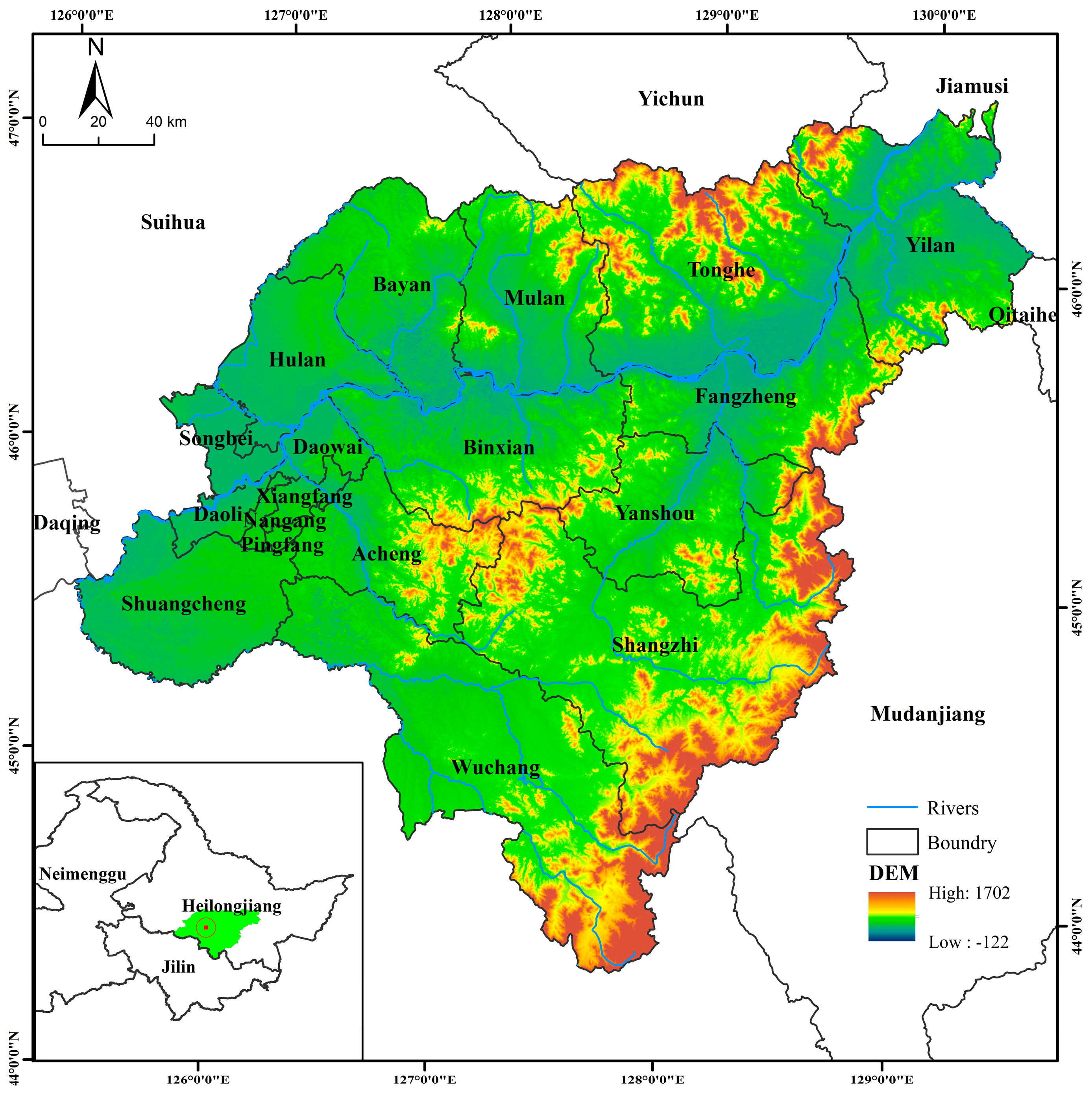
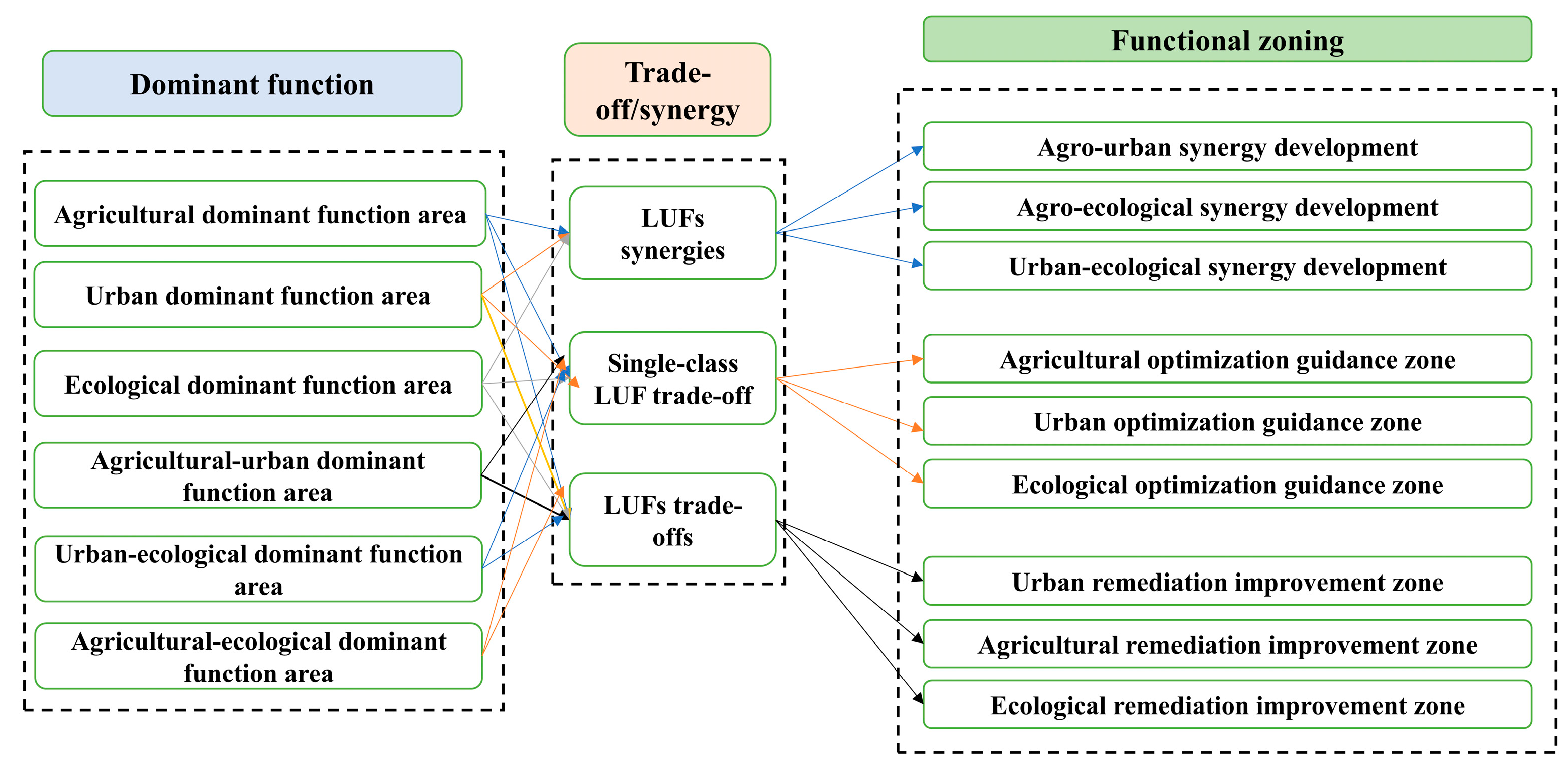
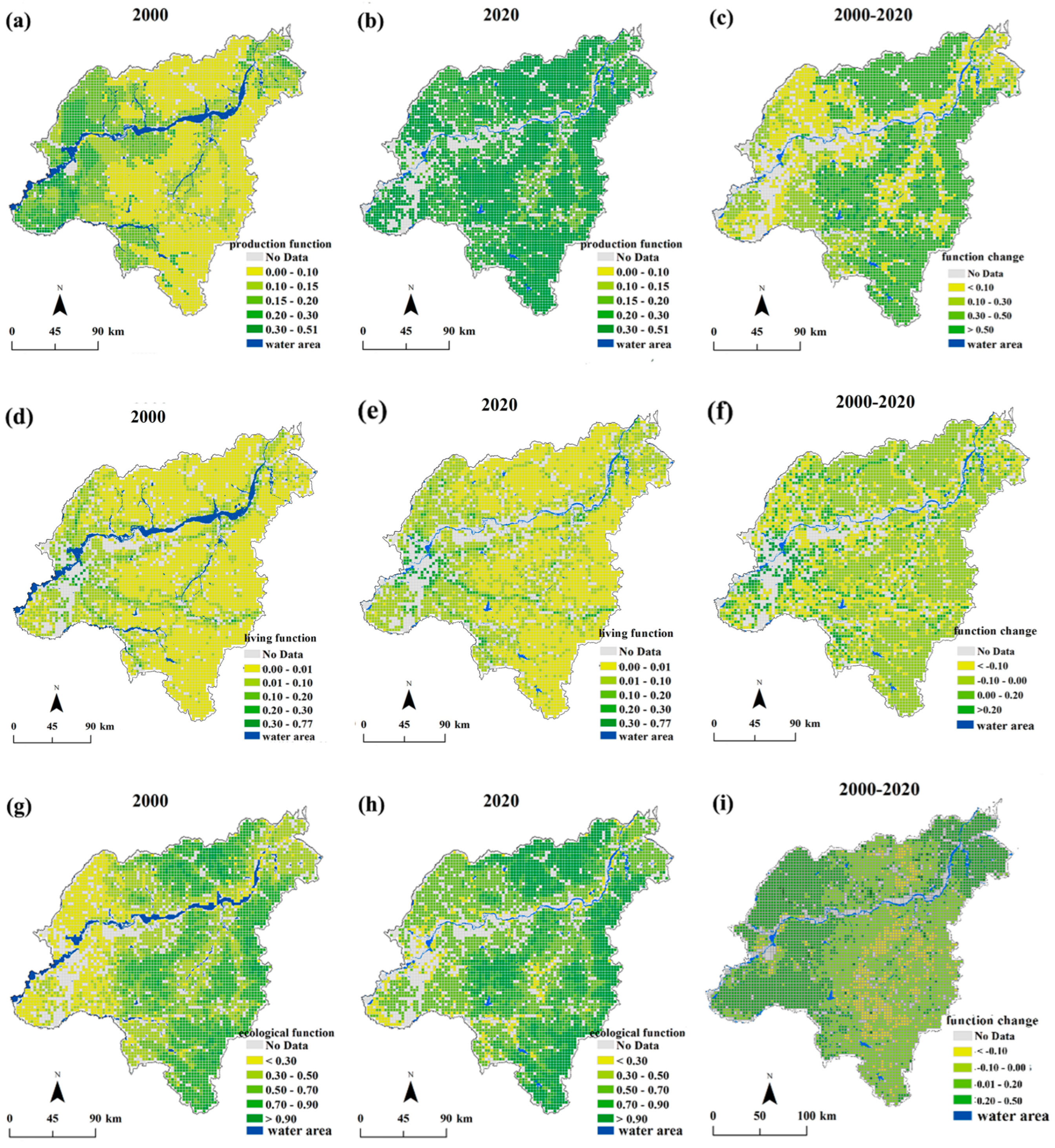

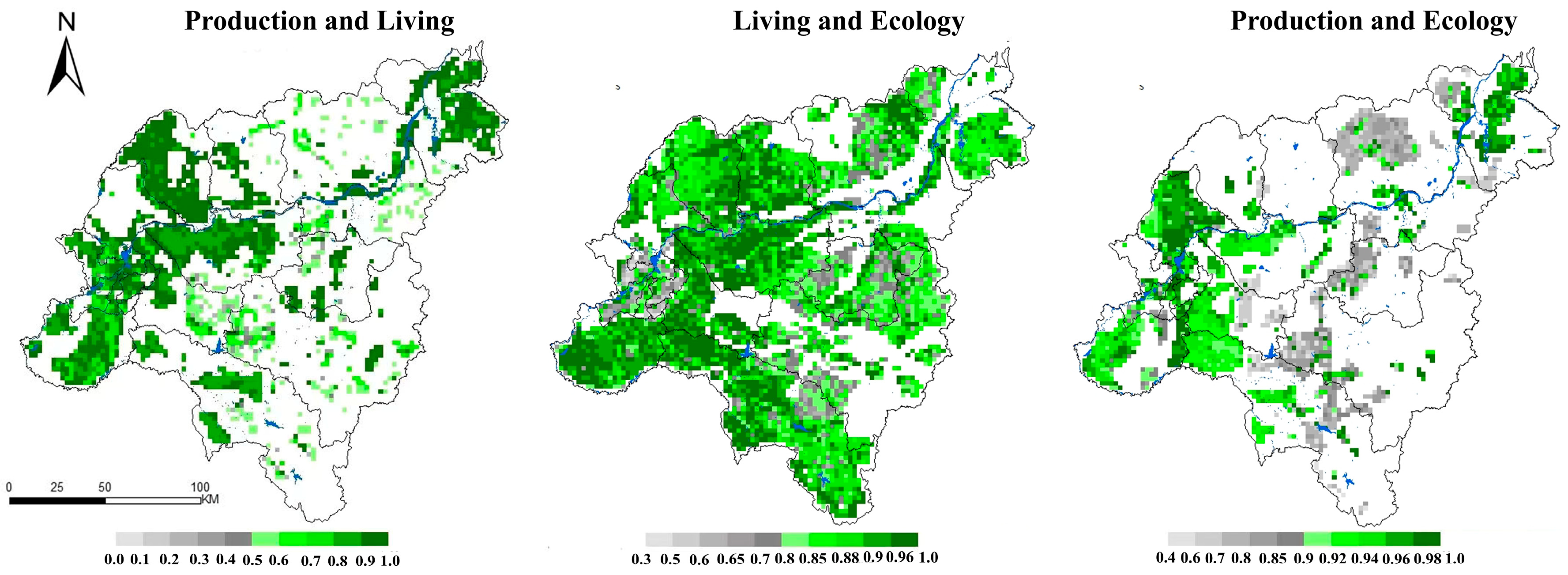

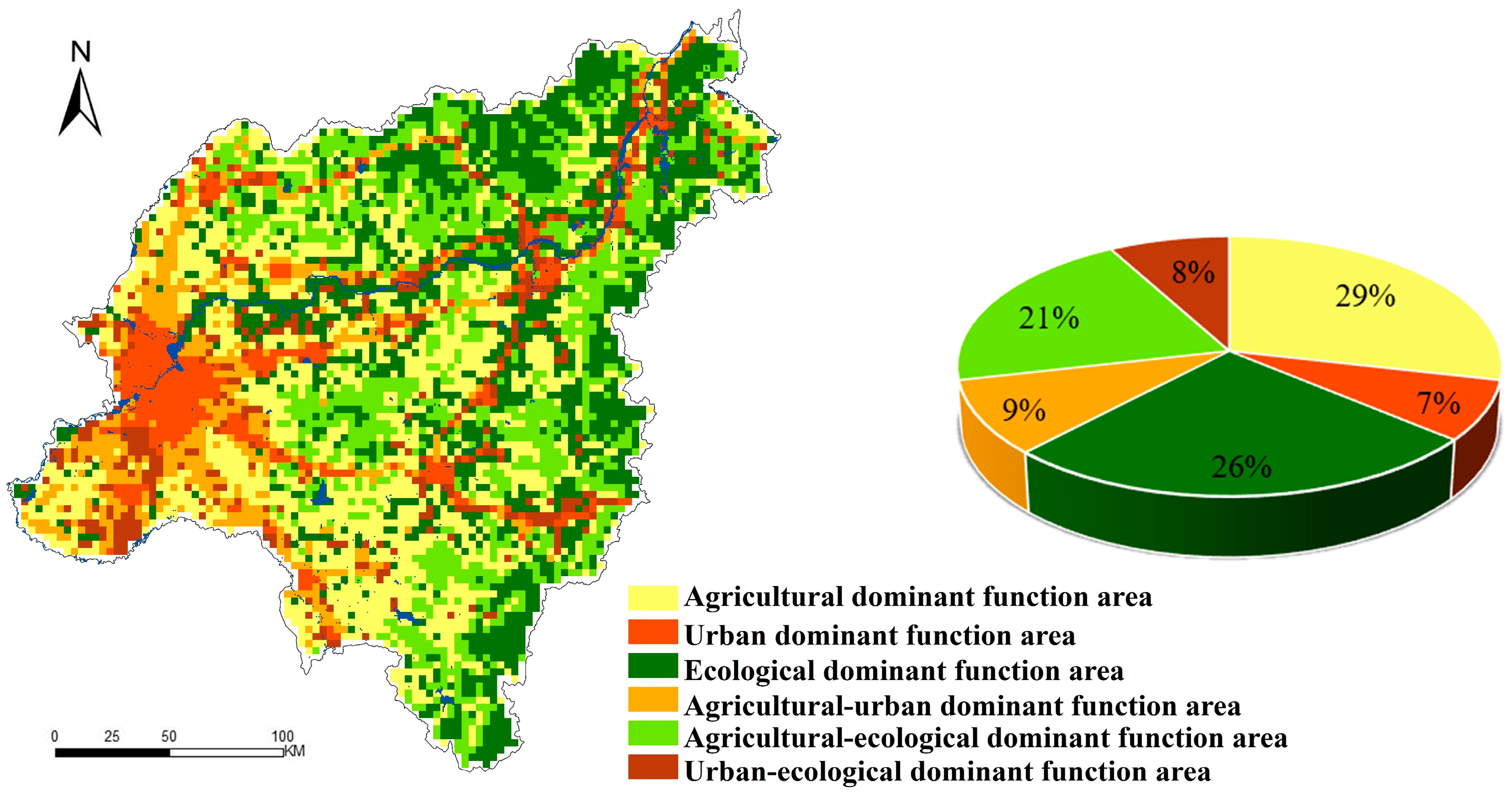

| Data Name | Data Formats | Data Sources |
|---|---|---|
| Land use/cover data | Raster data (30 m × 30 m) | Data Center for Resources and Environmental Sciences, Chinese Academy of Sciences (RESDC) (https://www.resdc.cn/) (accessed on 12 April 2024) |
| NDVI | Raster data (30 m × 30 m) | Land Processes Distributed Active Archive Center (https://Ipdaac.usgs.gov/) (accessed on 12 April 2024) |
| Road nets | Vector data (1:10,000) | Harbin Bureau of Planning and Natural Resources Department of Natural |
| DMSP/OLS night-time light | Raster data (1000 m × 1000 m/500 m × 500 m) | Data Center for Resources and Environmental Sciences, Chinese Academy of Sciences (RESDC) (https://www.resdc.cn/) (accessed on 12 April 2024) |
| Soil | Vector data (1000 m × 1000 m) | Chinese Soil Database (https://vdb3.soil.csdb.cn/) (accessed on 12 April 2024) |
| Climate station records of precipitation | Site | Meteorological data center of China Meteorological Administration (https://data.cma.cn/) (accessed on 12 April 2024) |
| DEM | Raster data (30 m × 30 m) | Geospatial Data Cloud (https://www.gscloud.cn/ (accessed on 12 April 2024) |
| Net Primary Productivity (NPP) | Raster data (500 m × 500 m) | Land Processes Distributed Active Archive Center (https://Ipdaac.usgs.gov/ (accessed on 12 April 2024) |
| Socio-economic data | Harbin City Statistical Yearbook | Harbin Bureau of Statistics (https://si12333.cn/ (accessed on 12 April 2024) |
| Primary Function | Secondary Function | Evaluation Methods | Explanations |
|---|---|---|---|
| Production | Grain production | GPi = GPsum ∗ | GPsum represents the total regional grain production. NDVIi and NDVIsum represent NDVI for grid i and the sum of NDVI for the study area. |
| Forest product provisioning | and are the forest product yield at grid x and county j; and are the forest amount at grid x and county j, respectively. | ||
| Living | Level of economic development | Econx denotes non-agricultural economic density at grid x; NGDPj denotes the non-agricultural GDP of county j; cx and cj are the area of urban built-up land and independent industrial and mining land of grid x and county j, respectively; HSIx and HSIj represent the human settlement index of grid x and county j, respectively. | |
| Traffic support capability | Pi = | wm and rm represent the weight and length of the road type m, respectively; Gi represents the area of grid i. The weights of railway, expressway, national road, provincial road, and main urban road are 0.35, 0.25, 0.2, 0.15, and 0.05, respectively. | |
| Population carrying capacity | Null | A specialization method based on the DMSP/OLS Night-time Satellite data and urban-rural built-up land. | |
| Human health and recreation | Null | Average rate of participation in basic pension insurance, basic medical care insurance, and unemployment insurance. | |
| Provision of work | Null | Total employed population/total area of land. | |
| Ecology | Carbon Sequestration | CS = | Ai represents the area of land use type i; Ciabove, Cibelow, Cisoil, Cidead, respectively, represent the above-ground biological carbon density, underground biological carbon density, carbon density in soil, and carbon density of dead matters. |
| Soil retention capacity | SR is the soil retention capacity in t/(ha year); R is the rainfall erosion factor; K is the soil erodibility; LS is the slop length and steepness factor; C denotes cover and management factor; and P is conservation practice factor. | ||
| Habitat quality | ) | Q is the value of habitat quality; Hxj is the habitat suitability of land use type j; k is the half saturation constant; z is a scaling parameter that reflects the spatial heterogeneity, and Dxj denotes the total threat level in grid x with land use type j. | |
| Water yield | Yxj is the water yield (mm) of grid x for land use type j; AETxj is the actual evapotranspiration (mm) of grid x for the land use type j; and Px is the average annual precipitation (mm) of grid x. |
| Functions | Fitting Function | Correlation Coefficient |
|---|---|---|
| Grain Production, Economic Development, Carbon Sequestration | y = 0.98923x ^ 0.46584 | 0.99756 |
| Forest product, Traffic support capability, Soil retention capacity | y = 0.98999x ^ 0.30614 | 0.99587 |
| Population carrying capacity, Habitat quality, Provision of work | y = 0.99244x ^ 0.23356 | 0.99746 |
| Water yield, Human health, and recreation | y = 0.99517x ^ 0.19175 | 0.99914 |
| Land Use Function Type | 2000 | 2020 | 2000–2020 |
|---|---|---|---|
| Production–Living | 0.495 ** | −0.438 ** | −0.083 ** |
| Living–Ecology | −0.660 ** | −0.597 ** | 0.012 * |
| Production–Ecology | −0.467 ** | 0.691 ** | −0.225 ** |
Disclaimer/Publisher’s Note: The statements, opinions and data contained in all publications are solely those of the individual author(s) and contributor(s) and not of MDPI and/or the editor(s). MDPI and/or the editor(s) disclaim responsibility for any injury to people or property resulting from any ideas, methods, instructions or products referred to in the content. |
© 2024 by the authors. Licensee MDPI, Basel, Switzerland. This article is an open access article distributed under the terms and conditions of the Creative Commons Attribution (CC BY) license (https://creativecommons.org/licenses/by/4.0/).
Share and Cite
Zhao, Y.; Liu, J.; Zhang, J.; Zhang, X.; Li, H.; Gao, F.; Zhan, Y. Spatial Identification and Evaluation of Land Use Multifunctions and Their Interrelationships Improve Territorial Space Zoning Management in Harbin, China. Land 2024, 13, 1092. https://doi.org/10.3390/land13071092
Zhao Y, Liu J, Zhang J, Zhang X, Li H, Gao F, Zhan Y. Spatial Identification and Evaluation of Land Use Multifunctions and Their Interrelationships Improve Territorial Space Zoning Management in Harbin, China. Land. 2024; 13(7):1092. https://doi.org/10.3390/land13071092
Chicago/Turabian StyleZhao, Yafang, Jiafu Liu, Jie Zhang, Xiaonan Zhang, Hongbo Li, Fengjie Gao, and Yucheng Zhan. 2024. "Spatial Identification and Evaluation of Land Use Multifunctions and Their Interrelationships Improve Territorial Space Zoning Management in Harbin, China" Land 13, no. 7: 1092. https://doi.org/10.3390/land13071092





